Effects of Added Dietary Fiber and Rearing System on the Gut Microbial Diversity and Gut Health of Chickens
Simple Summary
Abstract
1. Introduction
2. Materials and Methods
2.1. Animals, Feed and Experimental Design
2.2. Management
2.3. Sampling
2.4. Determination
2.4.1. 16S rRNA Gene Sequence
2.4.2. The Concentration of SCFAs
2.4.3. The Thickness of the Mucus Layer
2.4.4. GLP-1
2.5. Statistical Analysis
3. Results
3.1. The Determination of Gut Microbiota Diversity of CBRT
3.1.1. OTUs of CBRT
3.1.2. Gut Microbial Diversity Indexes of CBRT
3.1.3. The LEfSe of Significant Different Microbiota among Groups of CBRT
3.2. The Determination of Gut Microbiota Diversity of FBRT
3.2.1. OTUs of FBRT
3.2.2. Gut Microbial Diversity Indexes of FBRT
3.2.3. The LEfSe of Significantly Different Microbiota among FBRT
3.2.4. Comparison of Dominant Gut Microbiota among FBRT
3.3. Comparison of Gut Microbiota Diversity between CBRT and FBRT
3.3.1. Comparison of OTUs between CBRT and FBRT
3.3.2. Comparison of Gut Microbial Diversity Indexes between CBRT and FBRT
3.3.3. The LEfSe of Significant Different Microbiota among CBRT and FBRT
3.4. Functional Prediction of OTUs of CBRT-OL and FBRT-OL
3.5. Comparison of the Development of Intestine between FBRT and CBRT
3.6. Effects of Adding Dietary Fiber and Rearing System on SCFAs
3.7. The Thickness of the Cecum Inner Mucus Layer
3.7.1. Effect of Added Dietary Fiber on the Thickness of the Cecum Inner Mucus Layer
3.7.2. Effect of Rearing System on the Thickness of the Cecum Inner Mucus Layer
3.8. GLP-1
4. Discussion
4.1. The Effects of Added Dietary Fiber and Rearing System on Gut Microbial Diversity
4.2. The Effects of Added Dietary Fiber and Rearing System on Akkermansia and the Cecum Mucus Layer
4.3. The Effects of Added Dietary Fiber and Rearing System on SCFAs
4.4. The Effects of Added Dietary Fiber and Rearing System on GLP-1
5. Conclusions
Author Contributions
Funding
Acknowledgments
Conflicts of Interest
References
- Knierim, U. Animal welfare aspects of outdoor runs for laying hens: A review. NJAS Wagening. J. Life Sci. 2006, 54, 133–145. [Google Scholar] [CrossRef]
- De Jonge, J.; Van Trijp, H.C.M. The impact of broiler production system practices on consumer perceptions of animal welfare. Poult. Sci. 2013, 92, 3080–3095. [Google Scholar] [CrossRef] [PubMed]
- Vanhonacker, F.; Verbeke, W.; Tuyttens, F.A.M. Perception of Belgian chicken producers and citizens on broiler chicken welfare in Belgium versus Brazil. Poult. Sci. 2016, 95, 1555–1563. [Google Scholar] [CrossRef] [PubMed]
- Chen, S.; Xiang, H.; Zhu, X.; Zhang, H.; Wang, D.; Liu, H.; Wang, J.; Yin, T.; Liu, L.; Kong, M.; et al. Free dietary choice and free-range rearing improve the product quality, gait score, and microbial richness of chickens. Animals 2018, 8, 84. [Google Scholar] [CrossRef] [PubMed]
- Xu, Y.; Yang, H.; Zhang, L.; Su, Y.; Shi, D.; Xiao, H.; Tian, Y. High-throughput sequencing technology to reveal the composition and function of cecal microbiota in Dagu chicken. BMC Microbiol. 2016, 16, 259–268. [Google Scholar] [CrossRef]
- Cui, Y.; Wang, Q.; Liu, S.; Sun, R.; Zhou, Y.; Li, Y. Age-related variations in intestinal microflora of free-range and caged hens. Front. Microbiol. 2017, 8, 1310. [Google Scholar] [CrossRef]
- Heiman, M.L.; Frank, L. Greenway. A healthy gastrointestinal microbiome is dependent on dietary diversity. Mol. Metab. 2016, 5, 317–320. [Google Scholar] [CrossRef]
- Segata, N. Gut microbiome: Westernization and the disappearance of intestinal diversity. Curr. Biol. 2015, 25, R611–R613. [Google Scholar] [CrossRef]
- Moeller, A.H.; Li, Y.; Ngole, E.M.; Ahuka-Mundeke, S.; Lonsdorf, E.V.; Pusey, A.E.; Peeters, M.; Hahn, B.H.; Ochman, H. Rapid changes in the gut microbiome during human evolution. Proc. Natl. Acad. Sci. USA 2014, 111, 16431–16436. [Google Scholar] [CrossRef]
- Deehan, E.C.; Walter, J. The fiber gap and the disappearing gut microbiome: Implications for human nutrition. Trends Endocrinol. Metab. 2016, 27, 239–242. [Google Scholar] [CrossRef]
- Sonnenburg, E.D.; Smits, S.A.; Tikhonov, M.; Higginbottom, S.K.; Wingreen, N.S.; Sonnenburg, J.L. Diet-induced extinctions in the gut microbiota compound over generations. Nature 2016, 529, 212–215. [Google Scholar] [CrossRef] [PubMed]
- Larsen, N.; Vogensen, F.K.; van den Berg, F.W.J.; Nielsen, D.S.; Andreasen, A.S.; Pedersen, B.K.; Al-Soud, W.A.; Sørensen, S.J.; Hansen, L.H.; Jakobsen, M. Gut microbiota in human adults with type 2 diabetes differs from non-diabetic adults. PLoS ONE 2010, 5, e9085. [Google Scholar] [CrossRef] [PubMed]
- Ott, S.J.; Musfeldt, M.; Wenderoth, D.F.; Hampe, J.; Brant, O.; Fölsch, U.R.; Timmis, K.N.; Schreiber, S. Reduction in diversity of the colonic mucosa associated bacterial microflora in patients with active inflammatory bowel disease. Gut 2004, 53, 685–693. [Google Scholar] [CrossRef]
- Human Microbiome Project (HMP) Consortium. Structure, function and diversity of the healthy human microbiome. Nature 2012, 486, 207–214. [Google Scholar] [CrossRef]
- Qin, J.; Li, R.; Raes, J.; Arumugam, M.; Burgdorf, K.S.; Manichanh, C.; Nielsen, T.; Pons, N.; Levenez, F.; Yamada, T.; et al. A human gut microbial gene catalogue established by metagenomic sequencing. Nature 2010, 464, 59–65. [Google Scholar] [CrossRef]
- Gomez, A.; Petrzelkova, K.J.; Burns, M.B.; Yeoman, C.J.; Amato, K.R.; Vlckova, K.; Modry, D.; Todd, A.; Robinson, C.A.J.; Remis, M.J.; et al. Gut microbiome of coexisting BaAka pygmies and bantu reflects gradients of traditional subsistence patterns. Cell Rep. 2016, 14, 214–215. [Google Scholar] [CrossRef]
- Schnorr, S.L.; Candela, M.; Rampelli, S.; Centanni, M.; Consolandi, C.; Basaglia, G.; Turroni, S.; Biagi, E.; Peano, C.; Severgnini, M.; et al. Gut microbiome of the Hadza hunter-gatherers. Nat. Commun. 2014, 5, 1–13. [Google Scholar] [CrossRef]
- Moeller, A.H. The shrinking human gut microbiome. Curr. Opin. Microbiol. 2017, 38, 30–33. [Google Scholar] [CrossRef]
- Donohoe, D.R.; Garge, N.; Zhang, X.; Sun, W.; O’Connell, T.M.; Bunger, M.K.; Bultman, S.J. The microbiome and butyrate regulate energy metabolism and autophagy in the mammalian colon. Cell Metab. 2011, 13, 517–526. [Google Scholar] [CrossRef]
- Koh, A.; De Vadder, F.; Kovatcheva-Datchary, P.; Backhed, F. From dietary fiber to host physiology: Short-chain fatty acids as key bacterial metabolites. Cell 2016, 165, 1322–1345. [Google Scholar] [CrossRef]
- Duncan, S.H.; Hold, G.L.; Barcenilla, A.; Stewart, C.S.; Flint, H.J. Roseburia intestinalis sp. nov., a novel saccharolytic, butyrate-producing bacterium from human faeces. Int. J. Syst. Evol. Microbiol. 2002, 52, 1615–1620. [Google Scholar] [PubMed]
- Ferreira-Halder, C.V.; de Sousa Faria, A.V.; Andrade, S.S. Action and function of Faecalibacterium prausnitzii in health and disease. Best Pract. Res. Clin. Gastroenterol. 2017, 31, 643–648. [Google Scholar] [CrossRef] [PubMed]
- Earle, K.A.; Billings, G.; Sigal, M.; Lichtman, J.S.; Hansson, G.C.; Elias, J.E.; Amieva, M.R.; Huang, K.C.; Sonnenburg, J.L. Quantitative imaging of gut microbiota spatial organization. Cell Host Microbe 2015, 18, 478–488. [Google Scholar] [CrossRef] [PubMed]
- Troy, S.; Soty, M.; Ribeiro, L.; Laval, L.; Migrenne, S.; Fioramonti, X.; Pillot, B.; Fauveau, V.; Aubert, R.; Viollet, B.; et al. Intestinal gluconeogenesis is a key factor for early metabolic changes after gastric bypass but not after gastric lap-band in mice. Cell Metab. 2008, 8, 201–211. [Google Scholar] [CrossRef] [PubMed]
- De Vadder, F.; Kovatcheva-Datchary, P.; Goncalves, D.; Vinera, J.; Zitoun, C.; Duchampt, A.; Bäckhed, F.; Mithieux, G. Microbiota-generated metabolites promote metabolic benefits via gut-brain neural circuits. Cell 2014, 156, 84–96. [Google Scholar] [CrossRef] [PubMed]
- Coate, K.C.; Kliewer, S.A.; Mangelsdorf, D.J. Snapshot: Hormones of the gastrointestinal tract. Cell 2014, 159, 1478-1478el. [Google Scholar] [CrossRef]
- Brooks, L.; Viardot, A.; Tsakmaki, A.; Stolarczyk, E.; Howard, J.K.; Cani, P.D.; Everard, A.; Sleeth, M.L.; Psichas, A.; Anastasovskaj, J.; et al. Fermentable carbohydrate stimulates FFAR2-dependent colonic PYY cell expansion to increase satiety. Mol. Metab. 2017, 6, 48–60. [Google Scholar] [CrossRef]
- Singh, V.; San Yeoh, B.; Chassaing, B.; Xiao, X.; Saha, P.; Olvera, R.A.; Lapek, J.D., Jr.; Zhang, L.; Wang, W.B.; Hao, S.; et al. Dysregulated microbial fermentation of soluble fiber induces cholestatic liver cancer. Cell 2018, 175, 679–694. [Google Scholar] [CrossRef]
- Kroismayr, A. Choosing the right fibre for poultry-eubiotic lignocellulose. Int. Poult. Prod. 2014, 22, 17–19. [Google Scholar]
- Kroismayr, A.; Roberts, S.A. Eubiotic lignocellulose–a new tool for swine nutritionists. Int. Pig Top. 2010, 24, 23–25. [Google Scholar]
- Desai, M.S.; Seekatz, A.M.; Koropatkin, N.M.; Kamada, N.; Hickey, C.A.; Wolter, M.; Pudlo, N.A.; Kitamoto, S.; Terrapon, N.; Muller, A.; et al. A dietary fiber-deprived gut microbiota degrades the colonic mucus barrier and enhances pathogen susceptibility. Cell 2016, 167, 1339–1353. [Google Scholar] [CrossRef] [PubMed]
- Guo, M.; Wu, F.; Hao, G.; Qi, Q.; Li, R.; Li, N.; Wei, L.; Chai, T. Bacillus subtilis improves immunity and disease resistance in rabbits. Front. Immunol. 2017, 8, 354. [Google Scholar] [CrossRef] [PubMed]
- Edga, R.C. UPARSE: Highly accurate OTU sequences from microbial amplicon reads. Nat. Methods 2013, 10, 996–998. [Google Scholar] [CrossRef]
- Oksanen, J.; Blanchet, F.G.; Kindt, R.; Legendre, P.; O’hara, R.B.; Simpson, G.L.; Solymos, P.; Stevens, M.H.H.; Wagner, H. Vegan: Community ecology package. R package version 1.17-4. Acesso 2010, 23, 2010. [Google Scholar]
- Segata, N.; Izard, J.; Waldron, L.; Gevers, D.; Miropolsky, L.; Garrett, W.S.; Huttenhower, C. Metagenomic biomarker discovery and explanation. Genome Biol. 2011, 12, R60. [Google Scholar] [CrossRef]
- Aßhauer, K.P.; Wemheuer, B.; Daniel, R.; Meinicke, P. Tax4Fun: Predicting functional profiles from metagenomic 16S rRNA data. Bioinformatics 2015, 31, 2882–2884. [Google Scholar] [CrossRef]
- Huang, P.; Zhang, Y.; Xiao, K.; Jiang, F.; Wang, H.; Tang, D.; Liu, D.; Liu, B.; Liu, Y.; He, X.; et al. The chicken gut metagenome and the modulatory effects of plant-derived benzylisoquinoline alkaloids. Microbiome 2018, 6, 1–17. [Google Scholar] [CrossRef]
- Ley, R.E.; Hamady, M.; Lozupone, C.; Turnbaugh, P.J.; Ramey, R.R.; Bircher, J.S.; Schlegel, M.L.; Tucker, T.A.; Schrenzel, M.D.; Knight, R.; et al. Evolution of mammals and their gut microbes. Science 2008, 320, 1647–1651. [Google Scholar] [CrossRef]
- Knoop, K.A.; Newberry, R.D. Goblet cells: Multifaceted players in immunity at mucosal Surfaces. Mucosal Immunol. 2018, 7, 1551–1557. [Google Scholar] [CrossRef]
- Van den Abbeele, P.; Belzer, C.; Goossens, M.; Kleerebezem, M.; De Vos, W.M.; Thas, O.; De Weirdt, R.; Kerckhof, F.M.; Van de Wiele, T. Butyrate-producing clostridium cluster XIVa species specifically colonize mucins in an in vitro gut model. ISME J. 2013, 7, 949–961. [Google Scholar] [CrossRef]
- Everard, A.; Belzer, C.; Geurts, L.; Ouwerkerk, J.P.; Druart, C.; Bindels, L.B.; Guiot, Y.; Derrien, M.; Muccioli, G.G.; Delzenne, N.M.; et al. Cross-talk between Akkermansia muciniphila and intestinal epithelium controls diet-induced obesity. Proc. Natl. Acad. Sci. USA 2013, 110, 9066–9071. [Google Scholar] [CrossRef] [PubMed]
- Schroeder, B.O.; Birchenough, G.M.H.; Stählman, M.; Arike, L.; Johansson, M.E.; Hansson, G.C.; Bäckhed, F. Bifidobacteria or fiber protects against diet-induced microbiota-mediated colonic mucus deterioration. Cell Host Microbe 2018, 23, 27–40. [Google Scholar] [CrossRef] [PubMed]
- Van Passel, M.W.; Kant, R.; Zoetendal, E.G.; Plugge, C.M.; Derrien, M.; Malfatti, S.A.; Chain, P.S.; Woyke, T.; Palva, A.; de Vos, W.M.; et al. The genome of Akkermansia muciniphila, a dedicated intestinal mucin degrader, and its use in exploring intestinal metagenomes. PLoS ONE 2011, 6, e16876. [Google Scholar] [CrossRef] [PubMed]
- Shin, N.R.; Lee, J.C.; Lee, H.Y.; Kim, M.S.; Whon, T.W.; Lee, M.S.; Bae, J.W. An increase in the Akkermansia spp. population induced by metformin treatment improves glucose homeostasis in diet-induced obese mice. Gut 2014, 63, 727–735. [Google Scholar] [CrossRef]
- Derrien, M.; Van Hylckama Vlieg, J.E. Fate, activity, and impact of ingested bacteria within the human gut microbiota. Trends Microbiol. 2015, 23, 354–366. [Google Scholar] [CrossRef]
- Hilpert, W.; Dimroth, P. Conversion of the chemical energy of methylmalonyl-CoA decarboxylation into a Na+ gradient. Nature 1984, 296, 584–585. [Google Scholar] [CrossRef]
- Louis, P.; Young, P.; Holtrop, G.; Flint, H.J. Diversity of human colonic butyrate-producing bacteria revealed by analysis of the butyryl-CoA: Acetate CoA-transferase gene. Environ. Microbiol. 2010, 12, 304–314. [Google Scholar] [CrossRef]
- Frost, G.; Sleeth, M.L.; Sahuri-Arisoylu, M.; Lizarbe, B.; Cerdan, S.; Brody, L.; Anastasovska, J.; Ghourab, S.; Hankir, M.; Zhang, S.; et al. The short-chain fatty acid acetate reduces appetite via a central homeostatic mechanism. Nat. Commun. 2014, 5, 1–11. [Google Scholar] [CrossRef]
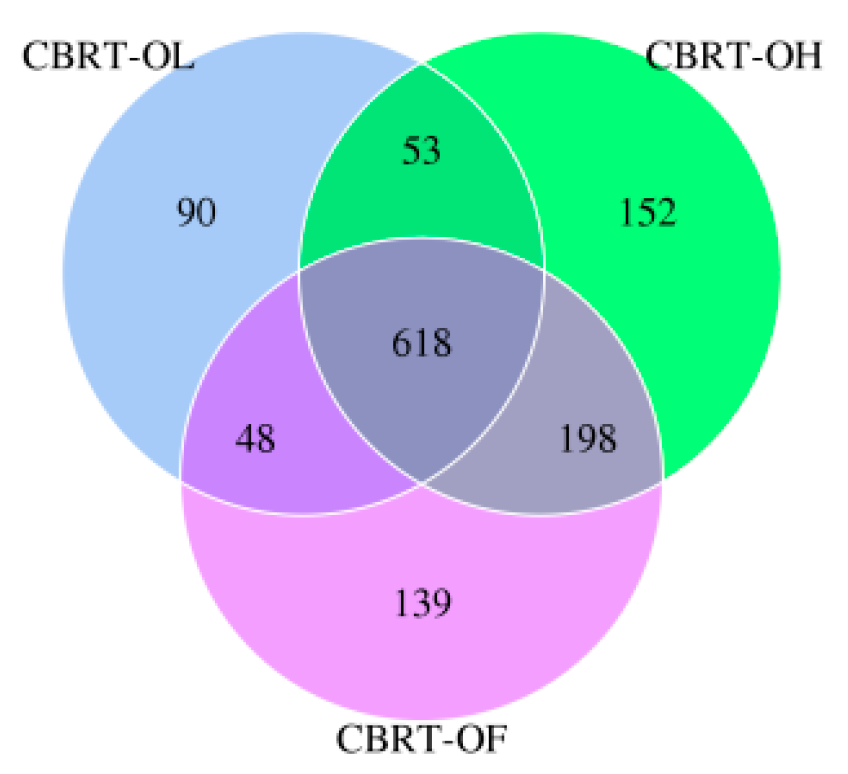


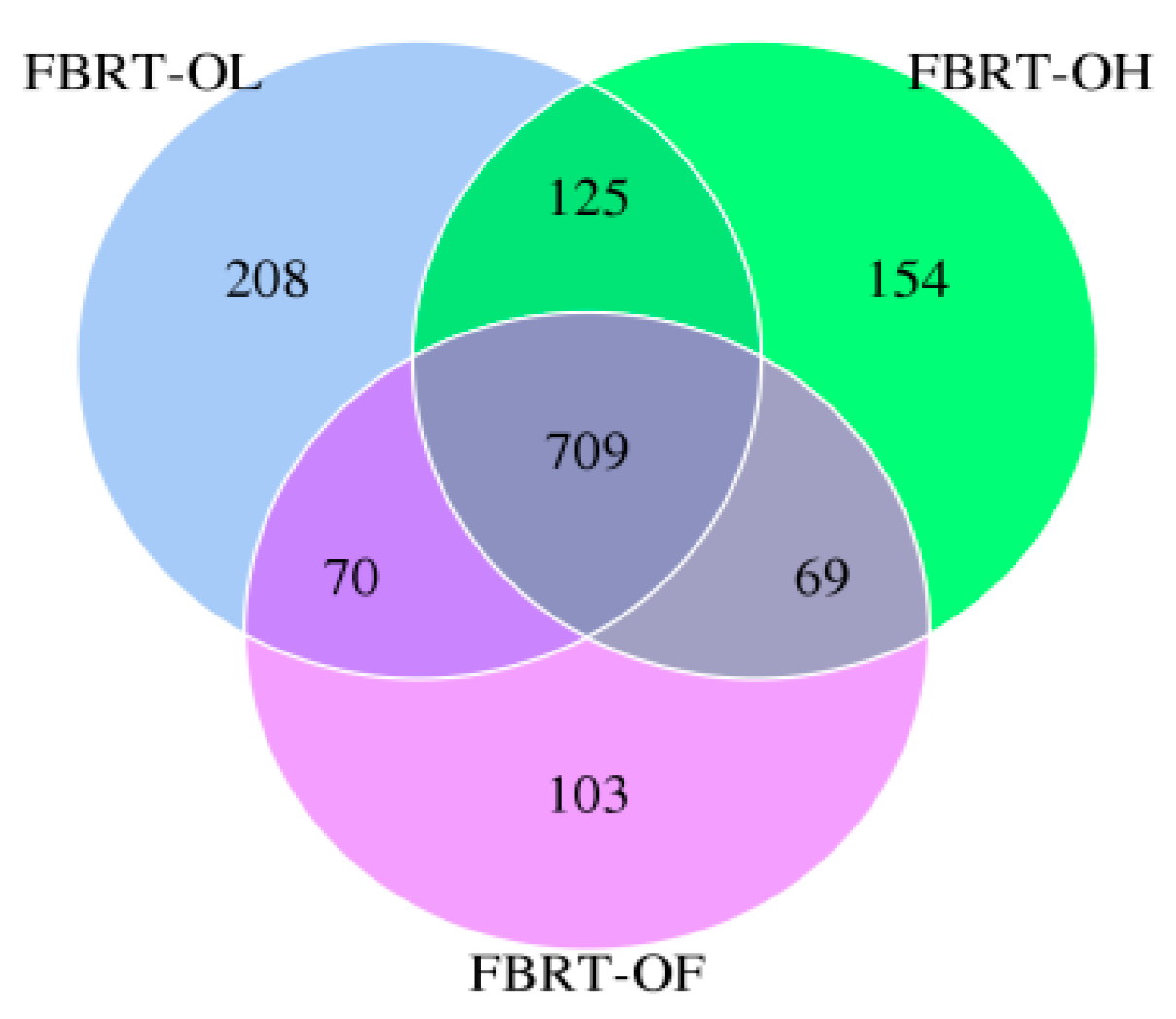
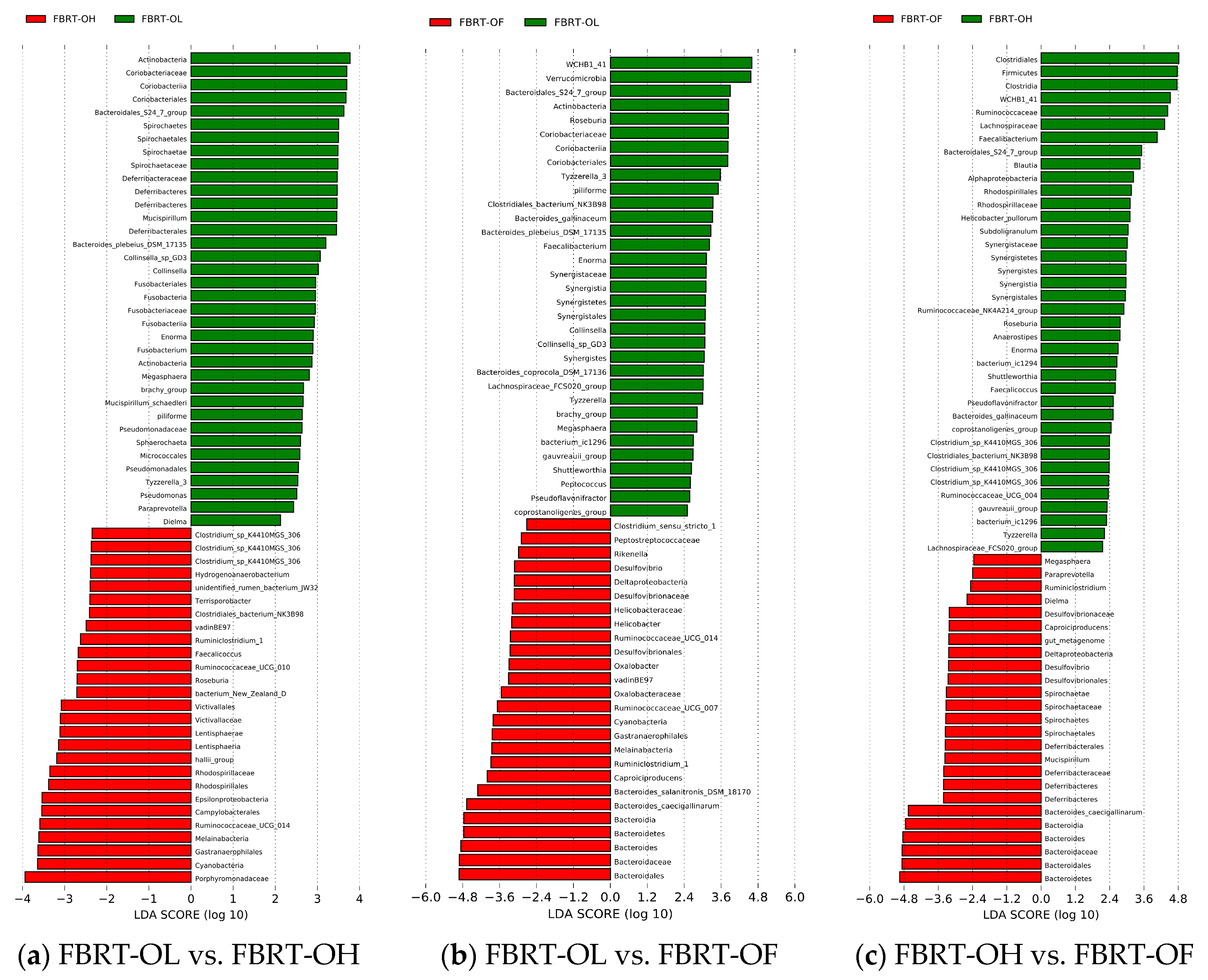
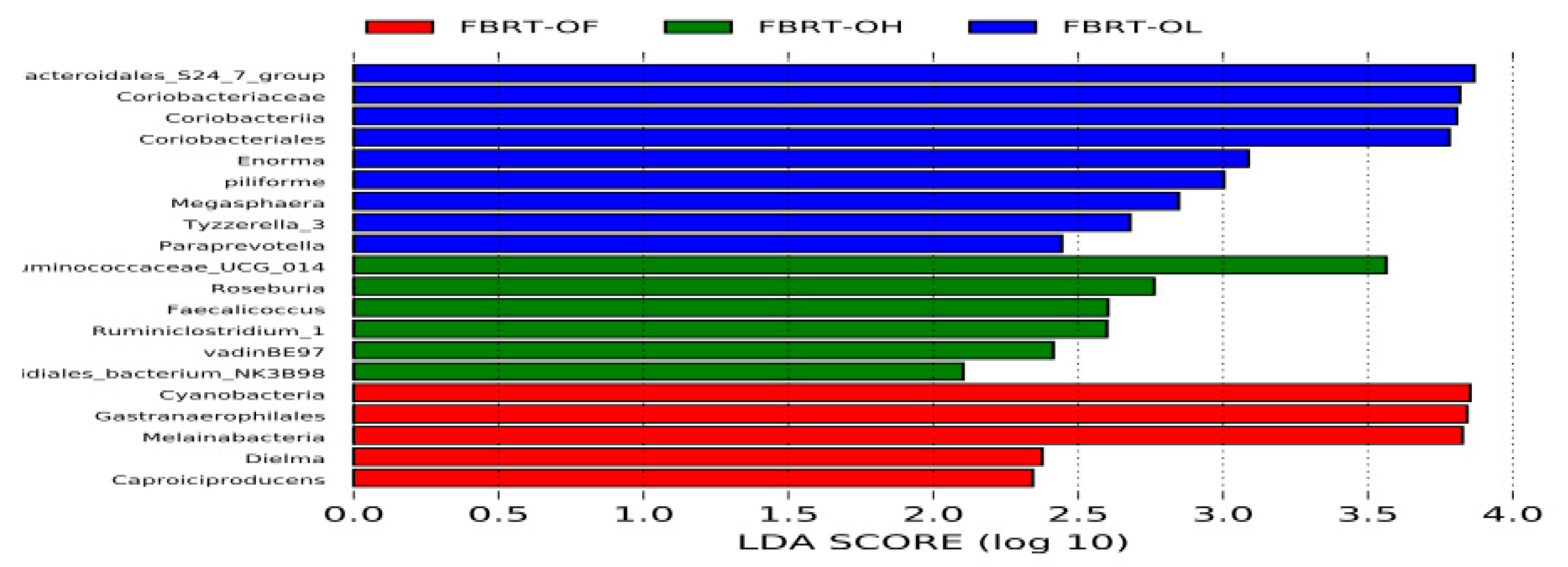

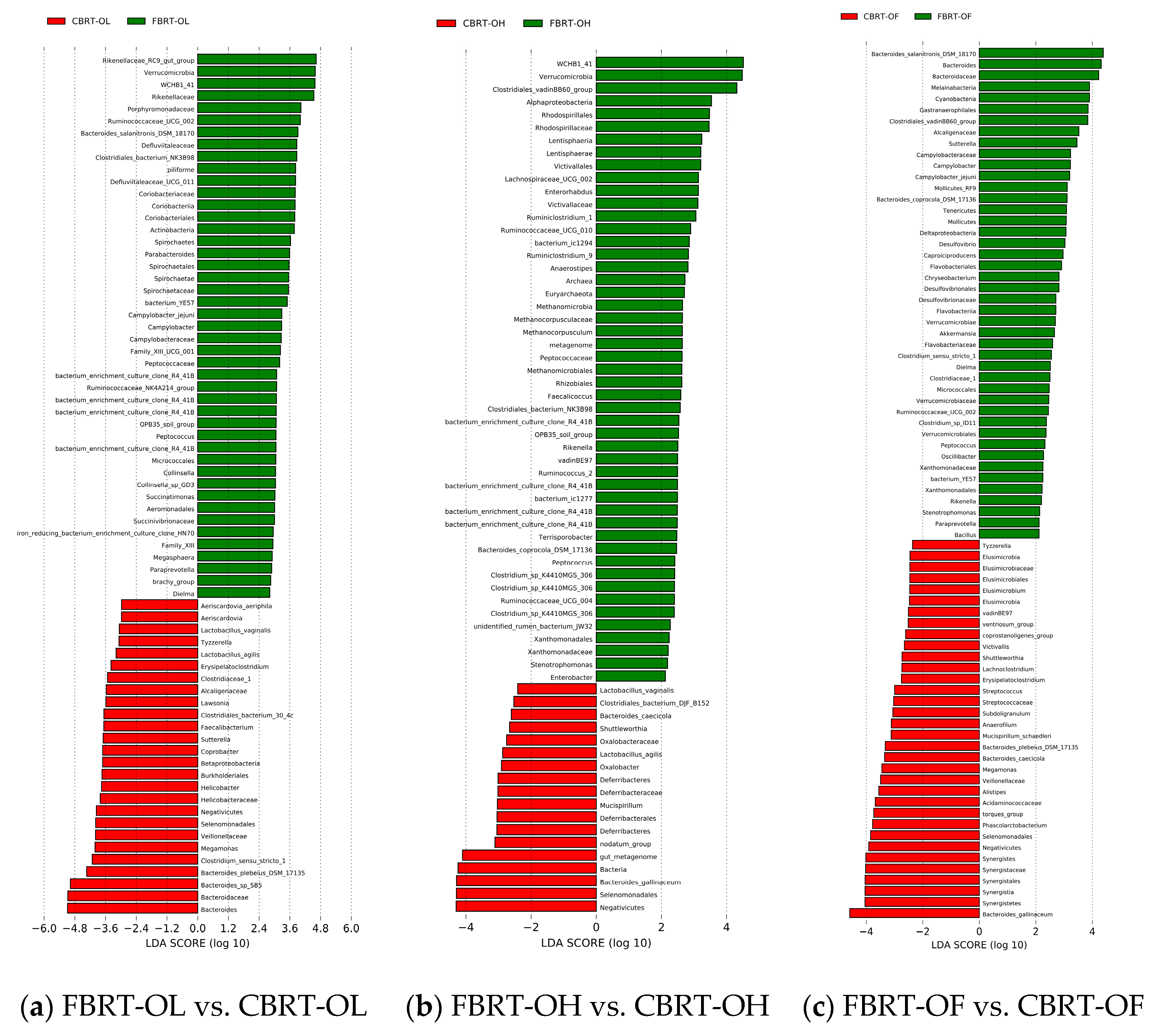
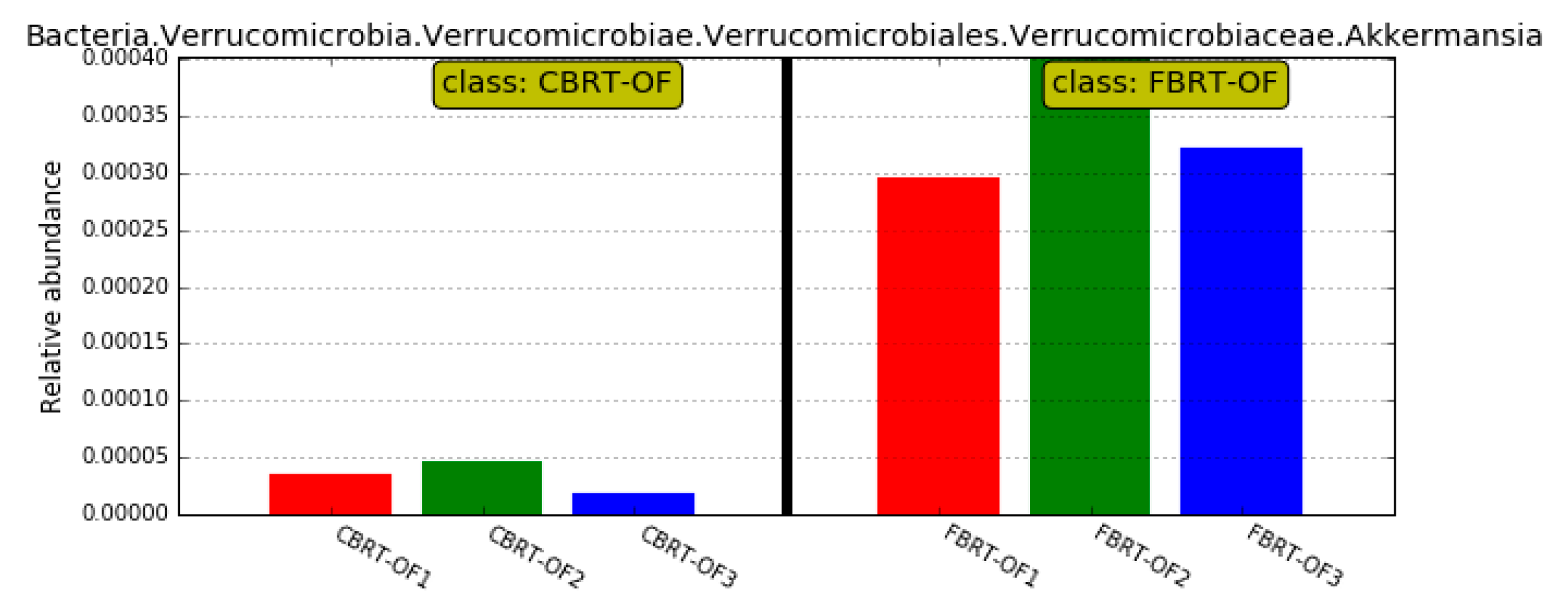
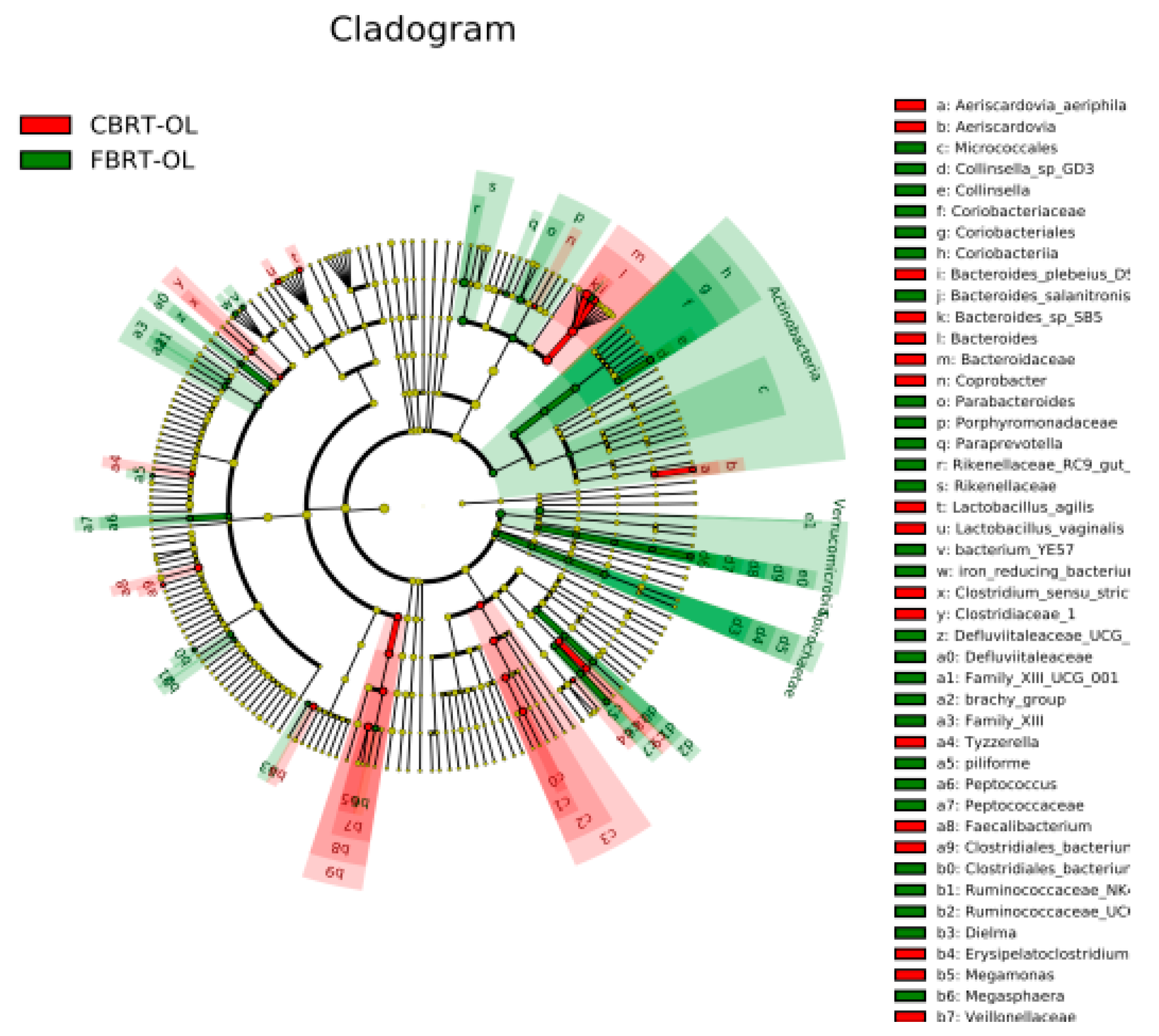
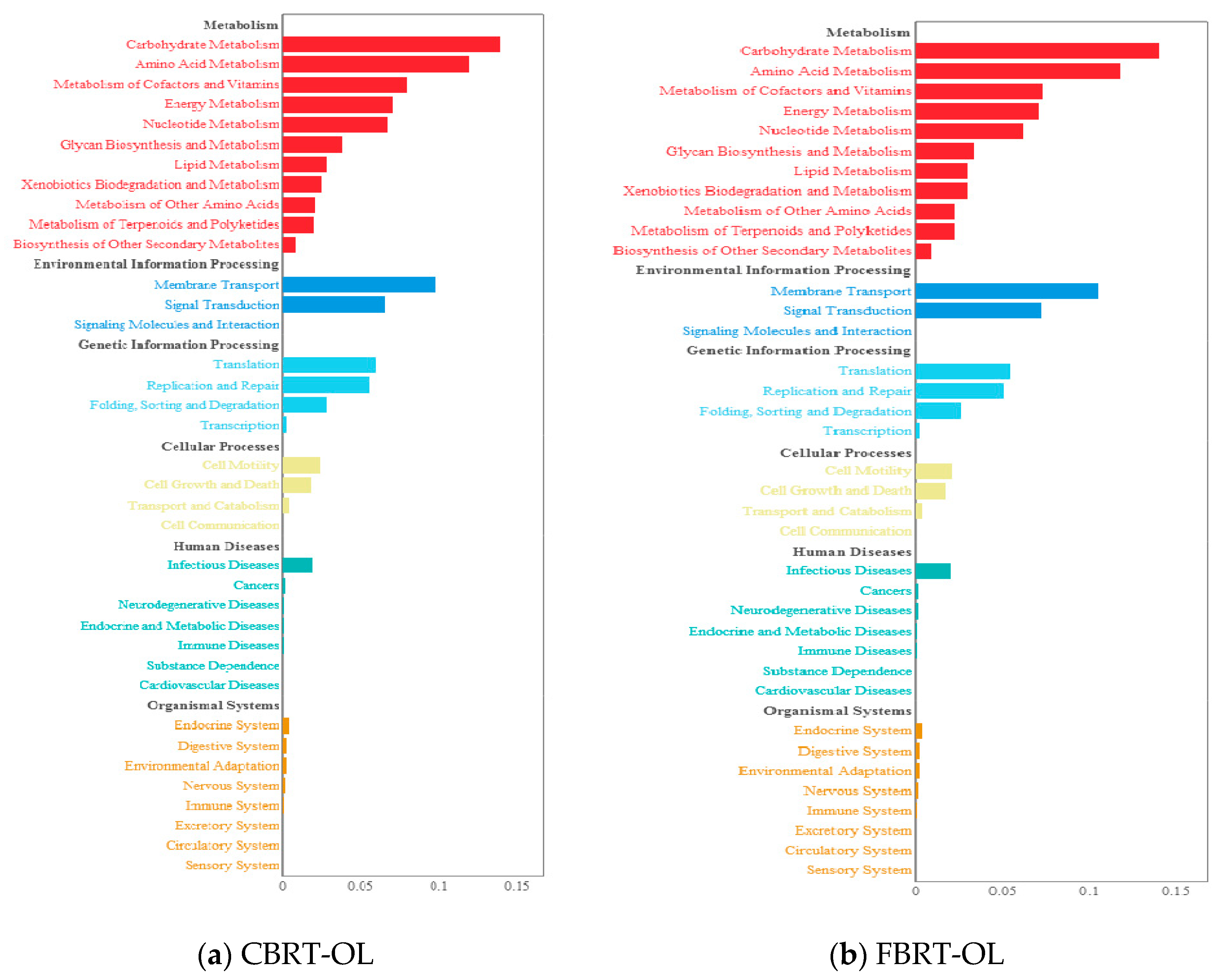

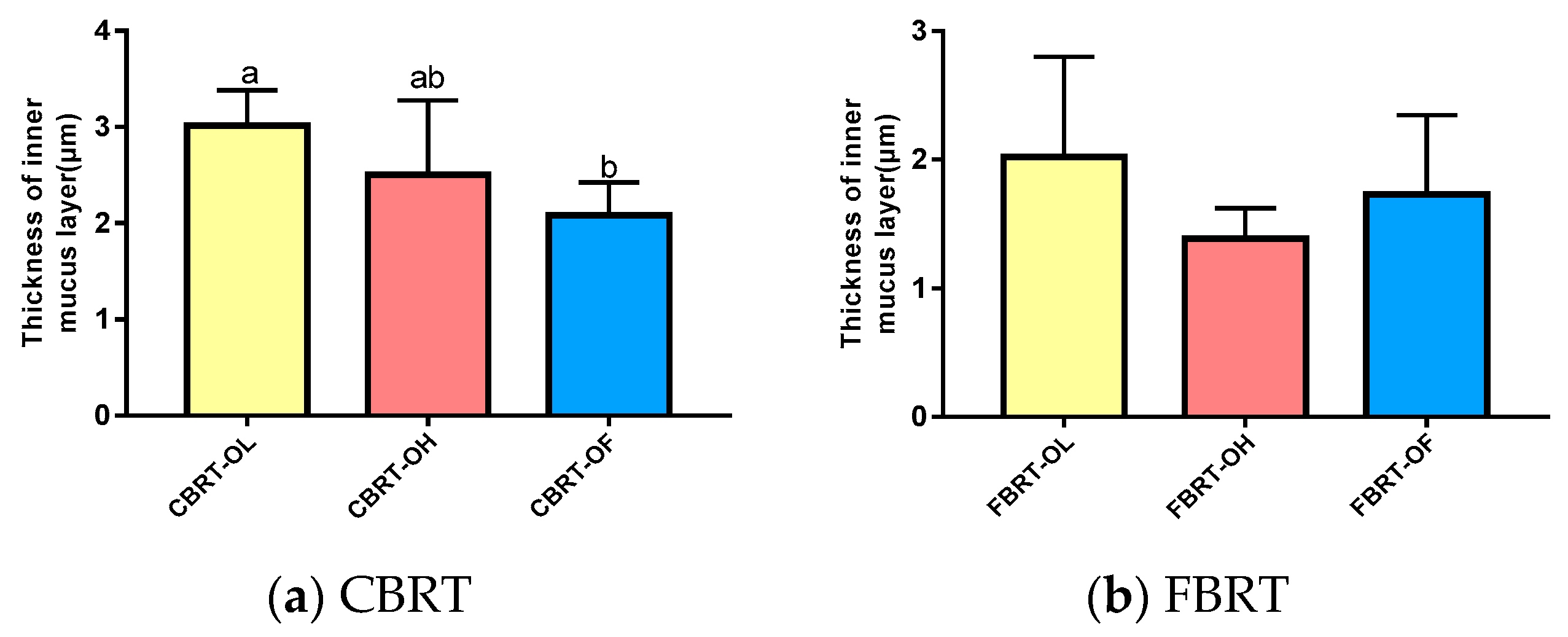

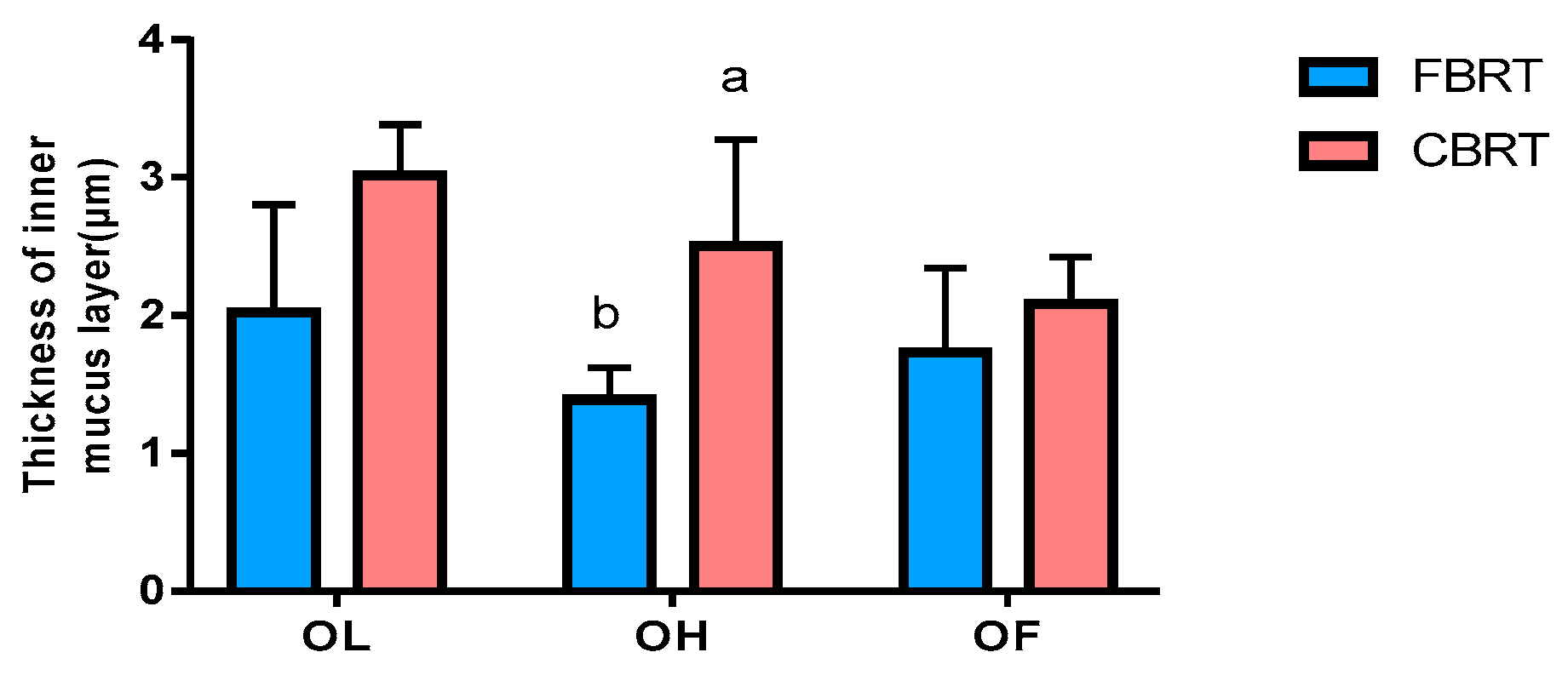
| Ingredients % | Feed Composition % | ||
|---|---|---|---|
| Corn | 61.95 | ME (MJ/kg) 1 | 12.43 |
| Soybean meal | 23.7 | Crude protein | 19.49 |
| Bran | 4 | Crude fiber | 3.21 |
| Soybean oil | 1.1 | Crude fat | 4.27 |
| Corn protein meal | 4 | Crude ash | 5.83 |
| Stone power | 1.8 | Ca | 1.05 |
| CaHPO4 | 1.3 | Total P | 0.57 |
| NaCI | 0.03 | NaCI | 0.3 |
| Methionine | 0.2 | Methionine | 0.49 |
| Lysine | 0.46 | Lysine | 0.99 |
| Threonine | 0.09 | Threonine | 0.68 |
| Multivitamin | 0.4 | Linoleic acid | 1.99 |
| Minerals | 0.55 | ||
| Choline chloride Complex enzyme | 0.1 0.05 |
| 9–15 Weeks | 16–20 Weeks | |||||
|---|---|---|---|---|---|---|
| Ingredients % | OL | OH | OF | OL | OH | OF |
| Corn | 66.28 | 67.55 | 65 | 65.27 | 66.55 | 64 |
| Soybean meal | 21.58 | 23.27 | 20 | 20.59 | 22.17 | 19 |
| Bran | 5.14 | 0.28 | 10 | 7.14 | 2.28 | 12 |
| Eubiotic lignocellulose 1 | 2 | 4 | 0 | 2 | 4 | 0 |
| Premix 2 | 5 | 5 | 5 | 5 | 5 | 5 |
| Calculated analysis (%) 3 | ||||||
| ME (MJ/kg) | 11.50 | 11.50 | 11.50 | 11.40 | 11.40 | 11.40 |
| Crude protein | 15.57 | 15.57 | 15.57 | 15.37 | 15.37 | 15.37 |
| Crude fiber | 4.15 | 5.02 | 3.30 | 4.25 | 5.11 | 3.40 |
| Crude fat | 3.15 | 3.05 | 3.24 | 3.17 | 3.07 | 3.26 |
| Crude ash | 2.45 | 2.35 | 2.56 | 2.47 | 2.37 | 2.58 |
| Ca | 0.99 | 0.99 | 0.98 | 0.98 | 0.99 | 0.98 |
| Total P | 0.46 | 0.43 | 0.49 | 0.47 | 0.44 | 0.50 |
| Acetate | Propionate | Butyrate | Isobutyrate | Isovalerate | Valerate | |
|---|---|---|---|---|---|---|
| Additive volume μL | 60 | 40 | 20 | 5 | 5 | 5 |
| Concentration 1 g/L | 0.63 | 0.40 | 0.19 | 0.048 | 0.047 | 0.047 |
| Mol concentration 2 mmol/L | 10.41 | 5.35 | 2.19 | 0.54 | 0.46 | 0.46 |
| CBRT-OL | CBRT-OH | CBRT-OF | |
|---|---|---|---|
| α-diversity | |||
| ACE | 1371.34 ± 97.82 B | 1810.22 ± 109.35 A | 1631.94 ± 55.75 A |
| Chao1 | 1375.74 ± 107.08 B | 1873.99 ± 100.77 A | 1721.33 ± 95.58 A |
| Shannon | 5.86 ± 0.27 B | 6.55 ± 0.067 A | 6.57 ± 0.13 A |
| Simpson | 0.92 ± 0.021 B | 0.97 ± 0.00094 A | 0.97 ± 0.0016 A |
| β-diversity | 0.16 ± 0.032 | 0.17 ± 0.039 | 0.17 ± 0.033 |
| FBRT-OL | FBRT-OH | FBRT-OF | |
|---|---|---|---|
| α-diversity | |||
| ACE | 1773.31 ± 43.86 a | 1772.66 ± 58.93 a | 1524.77 ± 6.28 b |
| Chao1 | 1818.33 ± 51.32 | 1799.93 ± 76.45 | 1616.26 ± 30.42 |
| Shannon | 7.19 ± 0.056 a | 6.87 ± 0.12 a,b | 6.66 ± 0.052 b |
| Simpson | 0.98 ± 0.00041 | 0.97 ± 0.0035 | 0.97 ± 0.0037 |
| β-diversity | 0.15 ± 0.025 A,B | 0.23 ± 0.061 A | 0.097 ± 0.0043 B |
| FBRT-OL | CBRT-OL | FBRT-OH | CBRT-OH | FBRT-OF | CBRT-OF | |
|---|---|---|---|---|---|---|
| α-diversity | ||||||
| ACE | 1773.31 ± 43.86 A | 1371.34 ± 97.82 B | 1772.66 ± 58.93 | 1810.22± 109.35 | 1524.77± 6.28 | 1631.94 ± 55.75 |
| Chao1 | 1818.33 ± 51.32 A | 1375.74 ± 107.08 B | 1799.93 ± 76.45 | 1873.99 ± 100.77 | 1616.26 ± 30.42 | 1721.33 ± 95.58 |
| Shannon | 7.19 ± 0.056 A | 5.86 ± 0.27 B | 6.87 ± 0.12 | 6.55 ± 0.067 | 6.66 ± 0.052 | 6.57 ± 0.13 |
| Simpson | 0.98 ± 0.00041 A | 0.92 ± 0.021 B | 0.97 ± 0.0035 | 0.97 ± 0.00094 | 0.97 ± 0.0037 | 0.97 ± 0.0016 |
| β-diversity | 0.15 ± 0.025 | 0.16 ± 0.032 | 0.23 ± 0.061 | 0.17 ± 0.039 | 0.097 ± 0.0043 | 0.17 ± 0.033 |
| OL | OH | OF | ||
|---|---|---|---|---|
| FBRT | small intestines (cm) | 125.75 ± 5.24 a | 120.2 ± 6.69 | 124.83 ± 4.90 |
| CBRT | small intestines (cm) | 108.58 ± 3.91 b | 111.3 ± 3.05 | 112.47 ± 6.41 |
| FBRT | cecum (cm) | 13.6 ± 0.50 | 13.1 ± 0.61 | 14.92 ± 0.81 |
| CBRT | cecum (cm) | 13 ± 1.08 | 13.67 ± 0.48 | 12.62 ± 0.34 |
| FBRT | cecum (g) | 5.24 ± 0.23 | 4.38 ± 0.23 | 5.59 ± 0.26 a |
| CBRT | cecum (g) | 4.47 ± 0.53 | 4.96 ± 0.36 | 4.64 ± 0.27 b |
| Acetate | Propionate | Butyrate | Isobutyrate | Isovalerate | Valerate | |
|---|---|---|---|---|---|---|
| Adding dietary fiber | ||||||
| CBRT-OL | 4.28 | 1.30 | 0.64 | 0.12 a,b | 0.13 | 0.15 |
| CBRT-OH | 4.09 | 1.50 | 0.58 | 0.086 a | 0.09 | 0.12 |
| CBRT-OF | 5.20 | 1.82 | 0.80 | 0.23 b | 0.32 | 0.17 |
| Pooled SEM | 0.54 | 0.16 | 0.12 | 0.026 | 0.052 | 0.018 |
| FBRT-OL | 4.50 | 1.58 | 1.00 | 0.18 | 0.27 | 0.18 |
| FBRT-OH | 4.57 | 1.37 | 0.63 | 0.13 | 0.17 | 0.14 |
| FBRT-OF | 5.67 | 1.97 | 0.92 | 0.14 | 0.22 | 0.16 |
| Pooled SEM | 0.33 | 0.16 | 0.14 | 0.017 | 0.026 | 0.015 |
| Rearing system | ||||||
| CBRT-OL | 4.28 | 1.30 | 0.64 | 0.12 | 0.13 | 0.15 |
| FBRT-OL | 4.50 | 1.58 | 1.00 | 0.18 | 0.27 | 0.18 |
| Pooled SEM | 1.14 | 0.43 | 0.37 | 0.046 | 0.06 | 0.053 |
| CBRT-OH | 4.09 | 1.50 | 0.58 | 0.086 b | 0.09 | 0.12 |
| FBRT-OH | 4.57 | 1.37 | 0.63 | 0.13 a | 0.17 | 0.14 |
| Pooled SEM | 0.22 | 0.13 | 0.10 | 0.008 | 0.02 | 0.008 |
| CBRT-OF | 5.20 | 1.82 | 0.80 | 0.23 | 0.32 | 0.17 |
| FBRT-OF | 4.36 | 1.46 | 0.51 | 0.15 | 0.18 | 0.13 |
| Pooled SEM | 1.22 | 0.19 | 0.21 | 0.062 | 0.11 | 0.036 |
| Added dietary fiber | 0.345 | 0.299 | 0.678 | 0.133 | 0.124 | 0.498 |
| Rearing system | 0.572 | 0.827 | 0.264 | 0.892 | 0.454 | 0.272 |
| Added dietary fiber × Rearing system | 0.986 | 0.617 | 0.438 | 0.116 | 0.191 | 0.455 |
| Inner Mucus Layer Thickness (μm) | |
|---|---|
| Added dietary fiber | |
| CBRT-OL | 3.01 a |
| CBRT-OH | 2.50 a,b |
| CBRT-OF | 2.09 b |
| Pooled SEM | 0.18 |
| FBRT-OL | 2.02 |
| FBRT-OH | 1.39 |
| FBRT-OF | 1.73 |
| Pooled SEM | 0.17 |
| Rearing system | |
| CBRT-OL | 3.01 |
| FBRT-OL | 2.02 |
| Pooled SEM | 0.28 |
| CBRT-OH | 2.50 a |
| FBRT-OH | 1.39 b |
| Pooled SEM | 0.23 |
| CBRT-OF | 2.09 |
| FBRT-OF | 1.73 |
| Pooled SEM | 0.22 |
| Added dietary fiber | 0.032 |
| Rearing systems | 0.003 |
| Added dietary fiber × Rearing system | 0.46 |
| GLP-1 (pmol/L) | |
|---|---|
| Added dietary fiber | |
| CBRT-OL | 12.46 |
| CBRT-OH | 11.58 |
| CBRT-OF | 12.05 |
| Pooled SEM | 0.25 |
| FBRT-OL | 8.94 |
| FBRT-OH | 9.91 |
| FBRT-OF | 10.20 |
| Pooled SEM | 0.23 |
| Rearing system | |
| CBRT-OL | 12.46 A |
| FBRT-OL | 8.94 B |
| Pooled SEM | 0.15 |
| CBRT-OH | 11.58 A |
| FBRT-OH | 9.91 B |
| Pooled SEM | 0.32 |
| CBRT-OF | 12.05 A |
| FBRT-OF | 10.20 B |
| Pooled SEM | 0.32 |
| Added dietary fiber | 0.46 |
| Rearing system | 0.00 |
| Added dietary fiber × Rearing system | 0.051 |
© 2020 by the authors. Licensee MDPI, Basel, Switzerland. This article is an open access article distributed under the terms and conditions of the Creative Commons Attribution (CC BY) license (http://creativecommons.org/licenses/by/4.0/).
Share and Cite
Hou, L.; Sun, B.; Yang, Y. Effects of Added Dietary Fiber and Rearing System on the Gut Microbial Diversity and Gut Health of Chickens. Animals 2020, 10, 107. https://doi.org/10.3390/ani10010107
Hou L, Sun B, Yang Y. Effects of Added Dietary Fiber and Rearing System on the Gut Microbial Diversity and Gut Health of Chickens. Animals. 2020; 10(1):107. https://doi.org/10.3390/ani10010107
Chicago/Turabian StyleHou, Linyue, Baosheng Sun, and Yu Yang. 2020. "Effects of Added Dietary Fiber and Rearing System on the Gut Microbial Diversity and Gut Health of Chickens" Animals 10, no. 1: 107. https://doi.org/10.3390/ani10010107
APA StyleHou, L., Sun, B., & Yang, Y. (2020). Effects of Added Dietary Fiber and Rearing System on the Gut Microbial Diversity and Gut Health of Chickens. Animals, 10(1), 107. https://doi.org/10.3390/ani10010107





